21 December. Swarms and bands on the Red Sea coast
The Desert Locust situation is threatening along both sides of the Red Sea where winter breeding is in progress in Egypt, Sudan and Saudi Arabia. Groups of adults and small swarms arrived on the coast last month from summer breeding areas in the interior of Sudan and laid eggs. Hatching occurred recently and hoppers are forming small groups and bands in sub coastal areas of Wadi Diib in northeast Sudan and southeast Egypt and in nearby coastal areas of Egypt. Egg-laying is continuing in Egypt and control operations are in progress. So far, infestations are confined only to the aforementioned areas. Elsewhere, low numbers of adults are present in the Tokar Delta, Sudan. In Saudi Arabia, egg-laying and hatching occurred on the coast north of Jeddah, and control operations are in progress against hopper bands that are forming. More hatching is expected in the coming weeks.
In the Western Region, locust infestations continue to decline in the northern Sahel of Mali, Niger and Chad. Nevertheless, groups of hoppers and adults persist in northern Niger where control operations continue. Control operations also continue in western Mauritania against hopper and adult groups. In Morocco, small-scale breeding continues in the southern part of the Western Sahara where small groups of egg-laying adults were treated. More hatching and the formation of small hopper groups and bands are expected in the coming weeks. In Algeria, control teams treated small groups of hoppers and egg-laying adults in the extreme south along the border of Mali and Niger.
Strict vigilance should continue in Mauritania, Morocco, Algeria and Libya during the coming weeks to detect any groups or swarms arriving from the Sahel. Thereafter, the threat should subside.
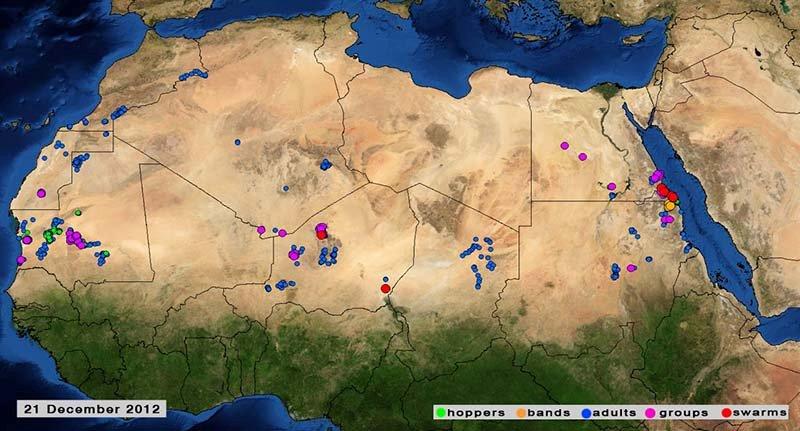
Winter breeding on the Red Sea coast.
3 December. Serious Desert Locust threat extends to NW and NE Africa
The Desert Locust situation remains serious as small swarms continue to form in Mali, Niger, and Chad, and adult groups have moved north to Libya, Tunisia and Algeria. An increasing number of adults were seen recently in Morocco and the Western Sahara. Locusts formed groups and small hopper bands in western Mauritania. More groups and small swarms are likely to form in the Sahel during December and move to Northwest Africa and northwest Mauritania.
In the Central Region, groups and swarms formed in northern Sudan and moved to Egypt and the Red Sea coast despite aerial and ground control. One group crossed the sea to the Saudi Arabian coast and scattered adults are present on the northern coastal plains.
Aerial control operations commenced in Algeria, Niger and Sudan. Ground control operations were also undertaken in Mauritania, Libya, Chad and Egypt.
All efforts are required to monitor the situation and undertake the necessary control operations.
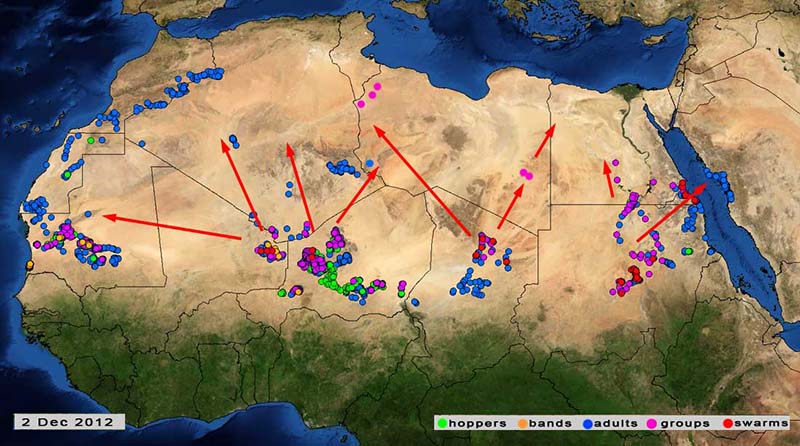
Current locust gregarization and migration.
22 November. Desert Locust threat extends to additional countries
In the past week, Desert Locust infestations have been reported in Libya, Morocco, Egypt and Saudi Arabia while increased activity occurred in Niger, Mauritania and Sudan.
A few small swarms formed on the Tamesna Plains in northern Niger and northeastern Mali as well as in northern Chad near Faya. Hoppers and adults continue to gregarize and form small groups in Niger, primarily on the Tamesna Plains, in the Air Mountains, and in some central areas. Ground control operations continue in Niger and to a lesser extent in Chad.
During periods of warm southerly winds, small groups of adults moved north into southern Algeria near In Guezzam, into northwest Libya near Ghadames and the border of Tunisia, and in southeast Libya near Kufra Oasis where control operations were carried out.
In Mauritania, ground control operations continue against groups of hoppers and adults in the northwest and centre. An increasing number of locusts were reported in the Western Sahara and along the southern side of the Atlas Mountains in Morocco.
In Sudan, ground and aerial control operations continue against small swarms that have been forming in the summer breeding areas of the interior and moving towards the northeast. Groups of adults were seen along the Nile Valley in the north as well as in adjacent areas of Upper Egypt near Abu Simbel where ground control operations are in progress. An increasing number of adults have been reported in the winter breeding areas in northeast Sudan, on the Red Sea coastal plains in southeastern Egypt where a small swarm was seen, and in the Tokar Delta, Sudan. A limited number of adults may have crossed the Red Sea to northern coastal plains of Saudi Arabia near Yenbo, north of Jeddah.
All efforts should continue to maintain and expand survey and control operations in the affected countries in order to reduce the scale of further migration and eventual breeding.
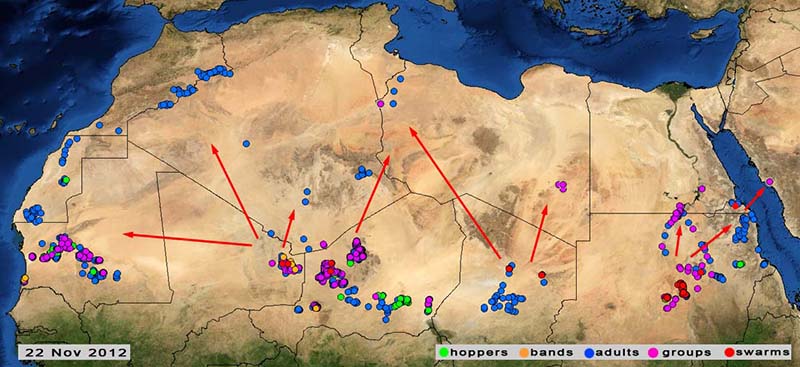
Current locust gregarization and migration.
13 November. Swarms form in Sudan and Mali
The Desert Locust situation remains serious. New reports indicate that second-generation adults are forming groups and small swarms in northeast Mali. In Niger and Mauritania, ground control operations continue against groups of hoppers and adults. Hopper bands are forming near Tahoua, Niger and on the coast in Mauritania, south of Nouakchott. Control operations were also carried out in southern Algeria against groups of adults near the Niger border. More groups and small swarms are expected to form in Mali and Niger and move to Algeria, Libya, northwest Mauritania and perhaps Morocco in the coming weeks.
In Sudan, ground and aerial control operations are in progress against swarms that have formed in the Baiyuda Desert north of Khartoum. Adults are moving towards the winter breeding areas along the Red Sea coast of Sudan.
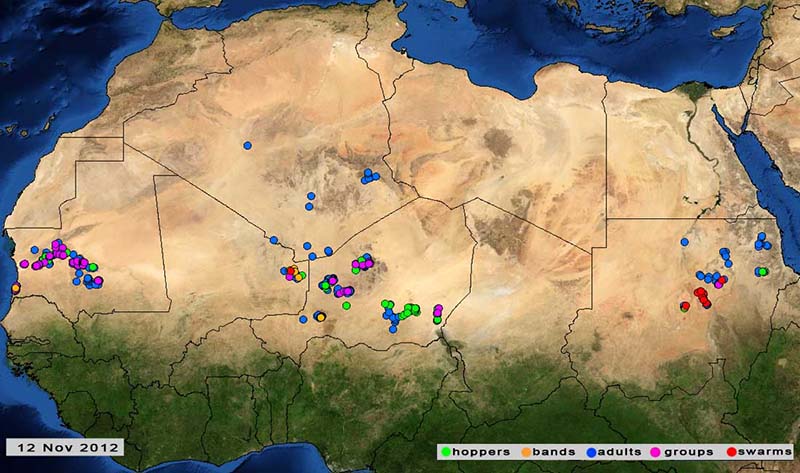
Locust breeding and gregarization in the Sahel.
5 November. Risk of locust migration to NW Africa and NW Mauritania
The Desert Locust situation remains serious as second-generation adults are forming small swarms in Chad and groups in Niger. A similar situation is likely in northern Mali but could not be confirmed due to insecurity.
Ground control operations continue in Niger and Chad. Although they have reduced locust numbers, there remains a high risk that additional adult groups and small swarms will form in November and migrate to western Libya, central Algeria, northwest Mauritania, Western Sahara and perhaps Morocco. A decline in swarm reports in Chad at the end of October suggests that migration may have already commenced in a few places. However, only local populations of scattered adults have been reported so far in Algeria, northeast Morocco, and the Western Sahara.
Locust numbers are increasing in western Mauritania as a result of local breeding. Ground control operations are in progress against small groups of hoppers and adults that are forming.
In the Central Region, ground teams treated hopper bands and groups of hoppers and adults in central Sudan. Low numbers of adults are currently moving from the summer breeding areas in the interior of Sudan to the Red Sea coast where winter breeding is expected to commence on a limited scale in November and December.
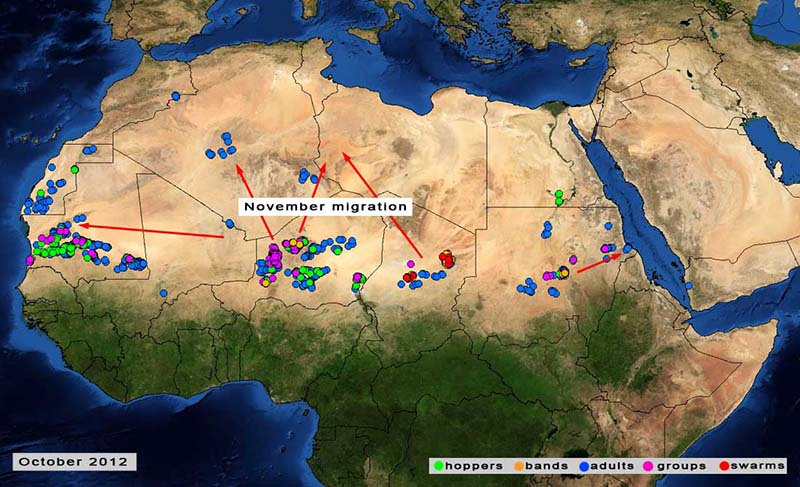
Locust breeding and expected migration in the Sahel.
26 October. Control operations underway in Niger and Chad
As the seasonal rains have ended in the Sahel and vegetation is drying out, Desert Locusts are concentrating and increasing in density in the few areas that are still green. Although current control operations are reducing locust numbers and infestations in Niger and Chad, migration to Northwest Africa is imminent, albeit on a smaller scale, since it is difficult to find and control all locust infestations in the northern Sahel.
In Chad, control operations are in progress against small swarms that continue to form in the northeast near Fada. In Niger, control teams are treating small groups of hoppers and adults that are forming near Tahoua, on the Tamesna Plains and along the western side of the Air Mountains. A few hopper bands have also been reported. The situation in northern Mali is expected to be similar to that in Niger and Chad but this cannot be confirmed due to insecurity. National survey teams continue to monitor cropping areas in central Mali where only a few isolated locusts have been detected so far.
As vegetation continues to dry out in the Sahel, more small groups and swarms are expected to form in Chad, Mali and Niger. In the coming weeks, they will migrate towards the north and west to western and central Libya, southern and central Algeria, and northwest Mauritania. Some swarms could reach western Algeria, southern Morocco and Western Sahara. The swarms are likely to settle in areas that receive rainfall where they will mature and lay eggs in about December. There is also a risk that a few swarms could move towards cropping areas in central and western Mali.
Local breeding is currently underway in northwest and central Mauritania where control operations are in progress against groups of hoppers and adults.
All countries in the Region have been informed to remain on high alert and take the necessary precautions. In addition, all efforts should continue to maintain and expand survey and control operations in the areas presently infested in Chad, Niger and Mauritania.
Elsewhere, control operations are underway in northern Sudan against groups of hoppers and adults near Khartoum. Low numbers of locusts recently arrived on the Red Sea coastal plains from the summer breeding areas in the interior of the country.
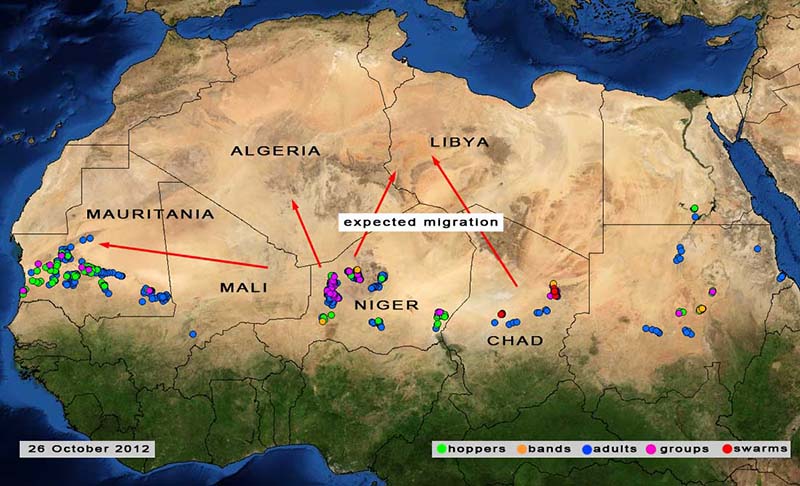
Locust breeding and expected migration in the Sahel.
12 October. DESERT LOCUST WARNING! Swarms forming in the Sahel
Desert Locust swarms are present in Chad and should start forming shortly in Niger and Mali. The swarms are expected to move towards North-West Africa in the coming weeks. Although unusually favourable ecological conditions allowed two generations of breeding this summer, the rains have ended and vegetation is drying out. This will cause locusts to concentrate and group in those areas that are still green in the Sahel and form hopper bands and swarms during the remainder of October and in November.
In Chad, immature swarms and hopper bands are present in the northeast near Fada where control operations are in progress. Hopper bands and swarms have also been reported further west near Kouba Oulanga. In Niger, hoppers and adults are forming groups on the Tamesna Plains and in the Air Mountains; control teams have treated 870 ha so far this month. In Mali, the situation is less clear in the north due to the prevailing insecurity but it is likely to be similar to the current situation in Niger and Chad. In Mauritania, hoppers and adults are forming groups in the northwest near Akjoujt and in the centre near Tidjikja; control teams treated 250 ha during the past week.
Once the swarms form, they are expected to migrate north and west from Chad, Mali and Niger and arrive in western and central Libya, southern and central Algeria, and northwest Mauritania during the second half of October. Some swarms could reach western Algeria, southern Morocco and Western Sahara. The swarms will settle in areas that receive rainfall, mature and lay eggs in about December. There is also a risk that a few swarms could move towards cropping areas in central and western Mali.
All countries in the Region should be on high alert from now onwards. Algeria, Libya, Mauritania and Morocco should immediately take the necessary precautions to prepare for survey and control operations. In Chad, Mali and Niger, all efforts should continue to maintain and expand survey and control operations in the infested areas.
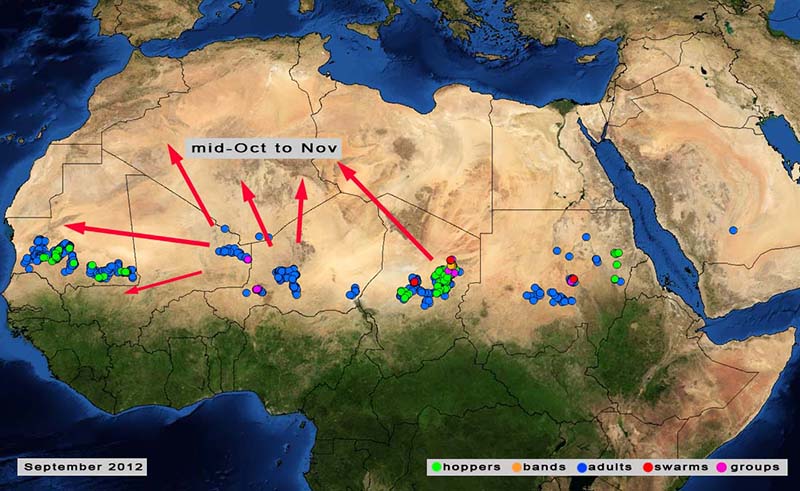
Locust breeding and expected migration in the Sahel.
2 October. Desert Locust situation remains serious in the Sahel of West Africa
The Desert Locust situation continues to remain serious as a second generation of breeding is underway in northern Mali, Niger and Chad. Smaller scale breeding has started recently in western Mauritania. Locust numbers will increase further in all areas as a result of the current breeding. So far, small hopper bands have formed in northeast Chad and control operations were undertaken. The situation is less clear in Mali as locust breeding areas in the north remain inaccessible.
Relatively large numbers of locusts are thought to be scattered throughout a sizeable portion of the northern Sahel. As vegetation dries out, hopper bands and swarms are likely to form in Mali, Niger and Chad. From mid-October onwards, there is an increasing risk that adult groups and small swarms will move out of the Sahel into Northwest Africa (southwest and central Libya, south and central Algeria), northwest Mauritania and perhaps reaching areas of recent rain in Western Sahara and western Algeria.
Surveys should be maintained in all affected countries and control operations carried out when appropriate in order to reduce locust numbers and the potential threat to crops and pastures. All countries in the region should remain on high alert.
Elsewhere, limited control operations were carried out in central Sudan where locusts were concentrating and forming groups. In South-West Asia, monsoon rains ended along the Indo-Pakistan border where the situation remains calm.

Locust breeding and expected migration in the Sahel.
17 September. Second generation breeding underway in Mali, Niger and Chad
As a result of unusually good rains and ecological conditions this summer, a second generation of Desert Locust breeding started this month in northeast Mali (Adrar des Iforas and Tamesna), in northern and central Niger (Tamesna and pasture zones) and in northeastern Chad (BET and Biltine). Hatching is likely to commence in the coming days in these countries. Hoppers are expected to be present during September and October, and fledging could start by mid-October, leading to an increase in the number of adults during the second half of October and in November.
In the past week, the Inter-Tropical Convergence Zone (ITCZ) has started to retreat southwards over the Sahel. Consequently, seasonal rains will end soon. As vegetation dries out, hoppers will concentrate and form small groups and bands while second generation adults will form small groups and swarms. The latter are likely to migrate in November from the northern Sahel in Mali, Niger and Chad to southern and central Algeria and Libya, to northwest Mauritania and perhaps reach southern Morocco. So far, a few small groups of first generation adults have been seen in Niger and Chad, and one small swarm was reported in Chad.
Current survey operations in Chad, Mali, Mauritania and Niger should be maintained, and increased if necessary, to ensure regular monitoring of all accessible breeding areas. Control operations will be required once locusts increase and concentrate to form suitable targets.
Elsewhere, small-scale breeding is in progress in Mauritania and Sudan where locust numbers remain low.
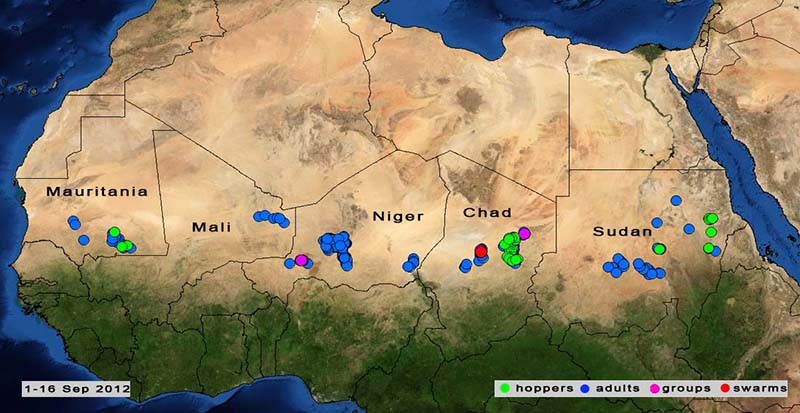
Locust breeding in the Sahel.
3 September. A second generation of breeding expected to commence shortly in Niger and Mali
The Desert Locust situation continues to remain serious as widespread breeding is in progress in Niger within a large portion of the northern desert, the central pasture areas and in parts of the south. Vegetation is much greener and is present up to 150 km further north than usual. Consequently, ecological conditions are favourable for a second generation of breeding that is expected to occur in Niger and Mali during September and October. This will cause locust numbers to increase further. As vegetation dries out, small groups, bands and swarms are expected to form in both countries from October onwards. Survey operations should be maintained in all affected countries and control operations carried out when possible in order to reduce locust numbers, the potential threat to crops and pastures and eventual migration to Northwest Africa.
The situation is less clear in northern Mali but is likely to be similar. There was an unconfirmed report of hopper bands in the north near Kidal last week.
Elsewhere, breeding on a smaller scale is in progress in Mauritania and Chad. Only low numbers of adults were reported in Sudan and along the Indo-Pakistan border.
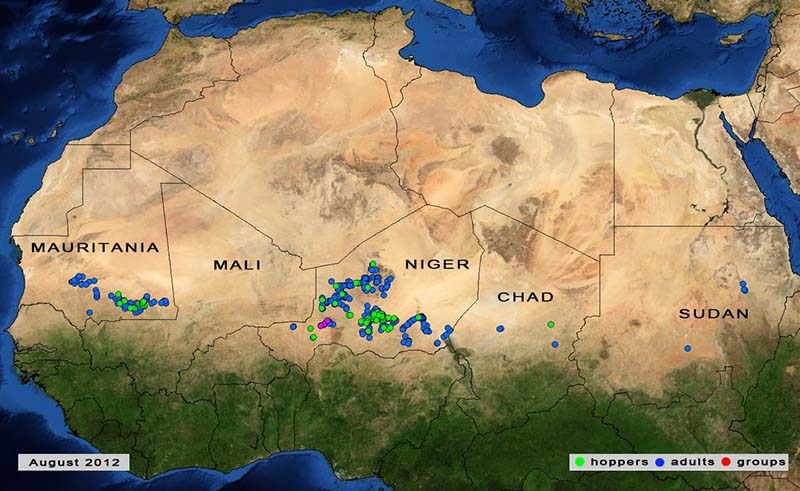
Locust breeding in Niger.
29 August. First generation adults increasing in Niger
Desert Locust breeding continues in central and northern Niger where ecological conditions remain favourable. Many of the hoppers have fledged and, consequently, an increasing number of immature adults have been reported recently. These adults should be ready to lay eggs by about mid-September.
There is no further information from Mali as teams cannot access the north due to insecurity. Nevertheless, the situation is likely to be similar to that in adjacent areas of northern Niger.
In Chad, surveys have resumed in the northern Sahel and, so far, only scattered adults have been seen.
In Mauritania, scattered adults are present in southern and central areas of the country, while small-scale breeding is underway mainly in the southeast. The situation remains calm.
Although current survey results may suggest that locust numbers are low, this may not accurately reflect the real situation. Therefore, surveys need to be maintained in all affected countries and control operations carried out when necessary in order to reduce locust numbers and the potential threat to crops and pastures.
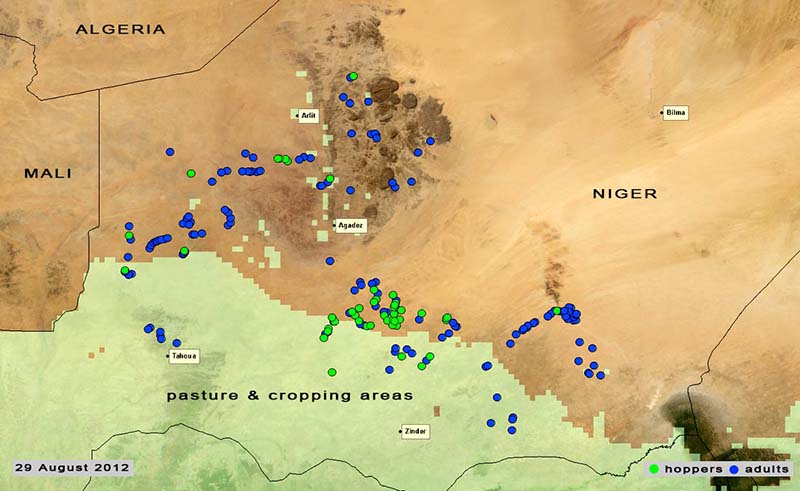
Locust breeding in Niger.
13 August. Breeding continues in Niger
Desert Locust breeding continues in Niger where first to fourth instar hoppers are present in central pasture areas in the Tadress and on the Latane Plains between Agadez and Zinder. Breeding is also underway in a few places of Tamesna. The hoppers originated from egg-laying and hatching during July. Fledging will occur during the second half of August, giving rise to an increasing number of immature adults. Good rains fell in most areas during the first decade of August. Ground surveys are in progress by national teams.
In Mali, no locusts were seen during national surveys in central areas near Nioro and Mopti, and in the west near Kayes. The situation is less clear in the north due to insecurity and the difficulty to conduct ground surveys in breeding areas.
In Mauritania, small-scale breeding is in progress in parts of the south where good rains fell in some areas during the first decade of August.
In Chad, good rains fell during the first decade in August throughout the northern Sahel. Regular surveys are recommended to monitor the situation.
Although current survey results may suggest that locust numbers are low, this may not accurately reflect the real situation. Therefore, surveys need to be maintained in all affected countries and control operations carried out when necessary in order to reduce locust numbers and the potential threat to crops and pastures.
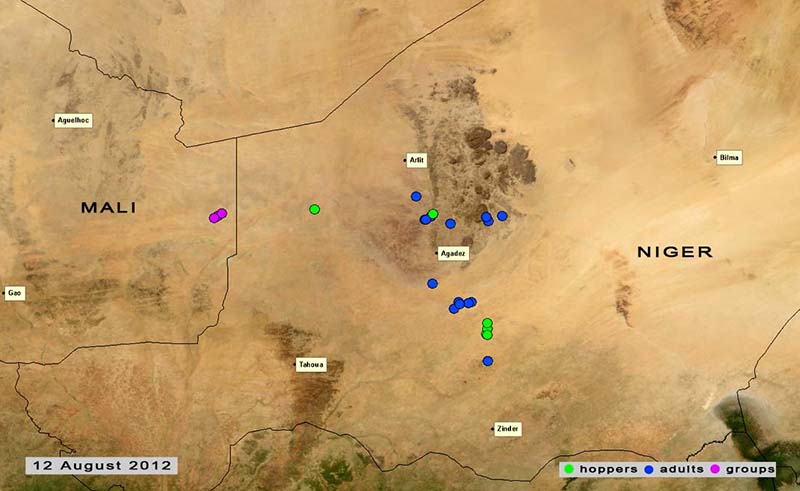
Locust breeding in Niger.
3 August. Egg-laying in progress in summer breeding areas
The Desert Locust situation continues to remain serious in West Africa as egg laying is in progress in northern Niger and Mali. So far, only limited hatching has been reported in Niger but additional hatching is expected in both countries that will cause locust numbers to increase. Hoppers could form groups and bands in August, and adult groups and small swarms could develop in September. Ground surveys are underway in both countries but are limited in northern Mali due to insecurity.
Smaller infestations are present in southern Mauritania, southern Algeria and eastern Chad where small-scale local breeding will cause locust numbers to increase during the forecast period.
Elsewhere, small-scale breeding is in progress in eastern Sudan and is expected to extend to Darfur, Kordofan and Northern regions during August as well as to the western lowlands of Eritrea. In Southwest Asia, breeding will be limited in Rajasthan, India and the Cholistan and Tharparkar deserts in Pakistan due to unusually poor monsoon rains so far.
Survey operations should be maintained in all affected countries and control operations carried out when possible in order to reduce locust numbers and the potential threat to crops and pastures.
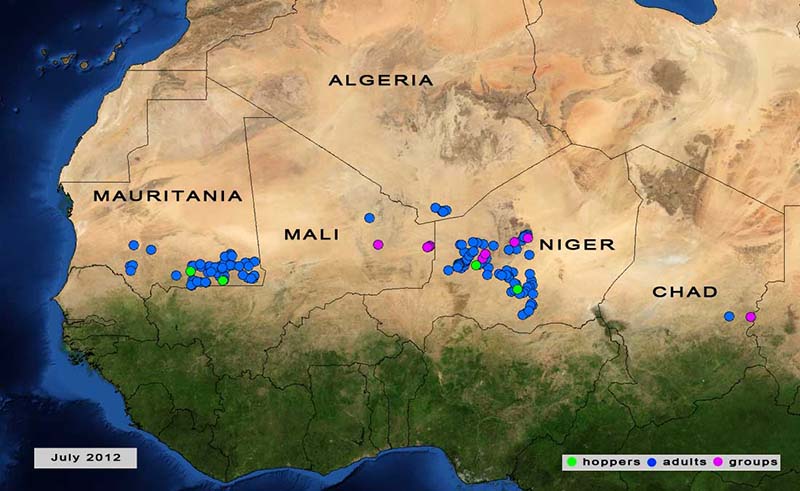
Summer breeding in the Sahel.
26 July. Breeding underway in northern Niger and Mali
Desert Locust adults have been laying eggs in northern Niger for the past two weeks. Most of the laying that has been detected so far by ground surveys has occurred in the southeast of the Air Mountains, in pasture areas between Agadez and Tanout, and on the southern part of the Tamesna Plains near Tassara. Groups of mature adults are present in Tamesna between In Gall and Tegguidda and in the southeast of the Air Mountains. Hatching has already occurred in a few places between Tassara and Tanout where isolated first to third instar hoppers are present. Additional survey teams are being mobilised to central and northern areas in the coming days.
In northern Mali, the locust situation and expected developments are likely to be similar to Niger but information is scarce as national ground teams cannot access the area due to insecurity. Nevertheless, local teams may be able to undertake some limited surveys. So far, groups of mature adults were seen between Gao and Kidal, and adults were maturing in the Tilemsi Valley west of the Adrar des Iforas. In central Mali, ground surveys are in progress north of Segou and east of Mopti where areas are secure and accessible. So far, no locusts have been reported.
In Chad, ground surveys are in progress in the west (Kanem) and east (Abeche to Adre) where only low numbers of locusts have been detected.
In Mauritania, ground surveys are in progress in the summer breeding areas in the south. So far, low numbers of mature adults are present and laying eggs, mainly near Nema.
The situation remains potentially dangerous as more egg-laying and hatching are expected in the coming weeks.
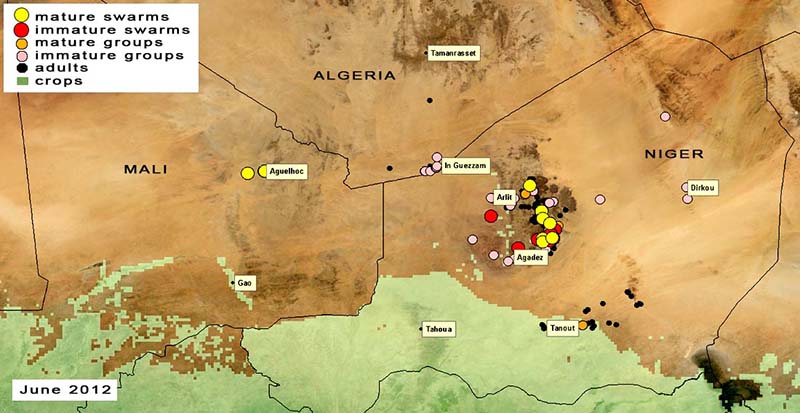
Desert Locusts are ready to lay eggs in Niger and Mali.
11 July. Breeding imminent in northern Niger and Mali
The Desert Locust situation remains potentially dangerous. Adults that arrived last month from Algeria and Libya have dispersed throughout northern Niger where they are maturing and ready to lay eggs. Some infestations were reported further south in the cropping areas of central and southern Niger between Tanout and Zinder.
Good rains fell in late June and the first part of July on the Tamesna Plains along both sides of the border in Niger and Mali as well as further south in the pasture and cropping areas of central and southern Niger. Consequently, most of the egg-laying is likely to take place in Tamesna, the Air Mountains, and in the pasture areas of central Niger. Hatching and hopper band formation are expected to occur this month. Since 5 June, ground teams have treated nearly 1,200 ha.
Ground surveys need to be increased, especially in those areas where rains have fallen recently, in order to determine the scale and extent of current breeding.
In northern Mali, the locust situation and expected developments are likely to be similar to those in Niger; however, ground teams cannot access potentially infested areas to confirm this due to insecurity. Nevertheless, it is assumed that breeding is underway in parts of the Adrar des Iforas and Tamesna.
In Algeria, survey teams are present in the extreme south along the borders of Mali and Niger where mature adults have been reported.
In Mauritania, ground surveys have commenced in the southeast where egg-laying is in progress west of Nema.
Surveys should start immediately in Chad.
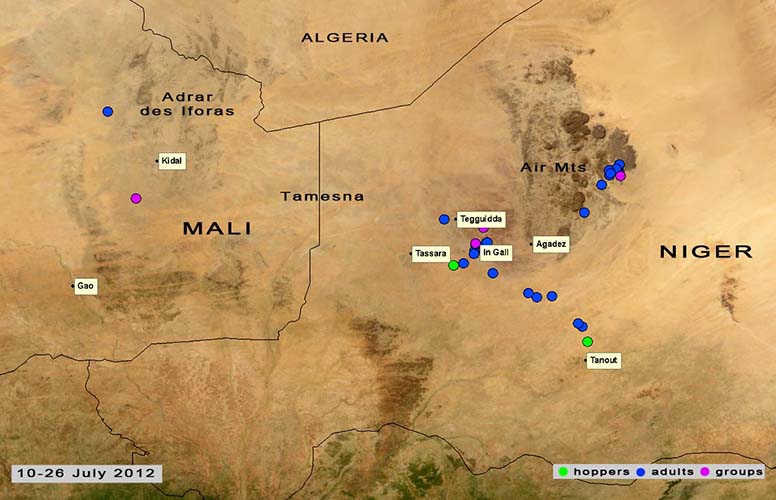
Egg-laying is underway in Niger.
3 July. Swarms and groups mature in northern Niger and Mali
The latest reports from the field indicate that Desert Locust adults are maturing in northern Niger and Mali where small groups and swarms are present. In the past few days, there has been an increasing number of immature and mature adults appearing in pasture areas of central Niger between Tanout and Termit. Adults were seen laying eggs in at least one place. Ground teams have treated 960 ha since 1 June. In southeast Mauritania, scattered adults have been reported. An immature group of adults was reported in eastern Chad near Adre and the border of Sudan. A similar infestation was reported in North Darfur, Sudan near Mellit.
A limited number of survey and control teams are operating in northern Niger but support is required urgently to enhance their capacity to intervene on a larger scale. Interventions will be limited in northern Mali due to insecurity. Nevertheless, support is required to increase national capacity to undertake survey and control operations in accessible areas to protect crops.
FAO has appealed for $10 million to support Sahelian countries to address the current Desert Locust threat. The funds are required for national survey and control operations in the infested areas as well as in pasture and cropping areas. The scale of control operations beyond the summer will depend on rainfall, locust developments and control operations during the next two months.
Surveys should start in the summer breeding areas in Mauritania, Chad and Sudan. Mauritania, Algeria, Libya and Morocco should prepare for a potential invasion this autumn.
The situation is potentially dangerous and action must be taken now.

Desert Locusts are ready to lay eggs in Niger and Mali.
26 June. Swarms and groups in northern Niger and Mali
In northern Niger, more than 17 groups of immature adults and small swarms from the north arrived between Arlit and Dirkou, including the Air Mountains and the Ténéré Desert, from 31 May to 11 June. Mature swarms were first seen on 6 June in the Air Mountains. Some adults moved further south and reached pasture areas in the northern cropping zones near Tanout. Damage was reported to date palms and cultivations in the Air and Ténéré. Ground teams have been deployed to the Air Mountains, Tabelot and the western Ténéré Desert, and in the grazing areas near Termit. Since 1 June, 740 ha have been treated.
In northern Mali, there have been many reports of locusts, including immature and mature swarms and adult groups near Aguelhoc, in Timetrine, and in wadis along the western side of the Adrar des Iforas. Nomads also reported locust infestations in the north. Although national survey and control teams cannot operate in the north, steps are underway to obtain information about the situation on a regular basis.
Breeding will occur this month in northern Niger and Mali, causing locust numbers to increase further. Hatching and band formation could commence in the coming days. Seasonal breeding will also start shortly in Mauritania and Chad.
In Northwest Africa, the situation has improved as locust numbers declined sharply due to the migration southwards to the northern Sahel. Only isolated adults are currently present in the extreme south of Algeria near In Guezzam and the border of Niger. In western Libya, travelers reported hopper bands on the Al Hamada Al Hamra plateau near Dirj. Survey teams are being redeployed to the southwest and west.
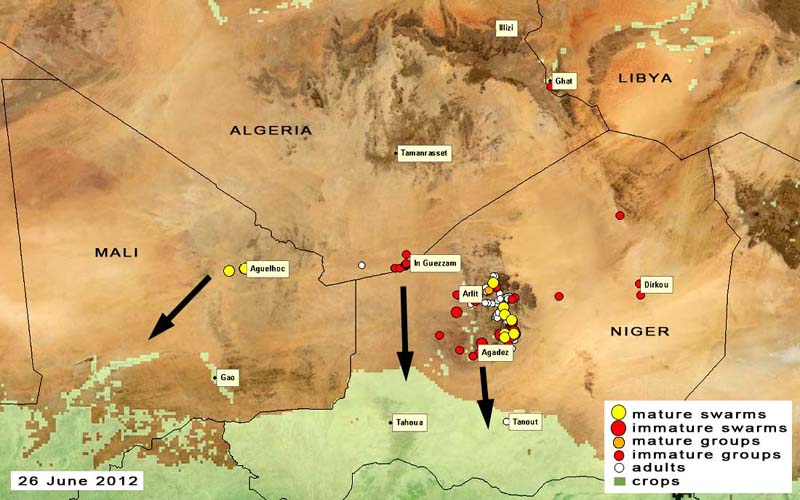
Desert Locusts are ready to lay eggs in Niger and Mali.
8 June. More locusts arrive in Niger and Mali from Algeria and Libya
More groups of immature Desert Locust adults, including a few swarms, have arrived in northern Niger and probably northern Mali during the past week. The locusts are coming from outbreak areas along both sides of the Algeria/Libya border where locust infestations are declining and control operations have been in progress since February but were hampered by insecurity.
In Niger, groups of immature adults have been reported throughout the north, mainly on the eastern side of the Tamesna Plains between Arlit and Agadez, in the Air Mountains, on the western edge of the Tenere Desert, and near Bilma and the Djado Plateau. At least one immature swarm was seen south of Arlit, and three mature swarms were seen in the Air Mountains moving south to the Sahelian zone. Adult groups and a few small swarms are expected to arrive in agricultural production areas in central Niger between Tahoua and Termit (northeast of Zinder), coinciding with the planting and emergence of this year's crops.
Good rains started about six weeks earlier than normal this year and breeding conditions are already favorable in the Sahel of Niger and Mali. Consequently, at least one and probably two generations of breeding will occur this summer and cause locust numbers to increase dramatically in Niger and Mali, and perhaps Chad. The first generation of egg-laying is expected to start in mid-June and continue into July. Control operations are likely to be necessary against hopper bands and swarms throughout the summer.
In Mali, nomads reported a large locust swarm in the Timetrine area of the north in late May.
Locust teams in Niger have been mobilized in the north and so far 25 ha have been treated. It is unlikely that teams in Mali will be able to operate in the north this summer. Nevertheless, all efforts are required to find the locust infestations and treat them in order to reduce locust numbers and protect agricultural crops.
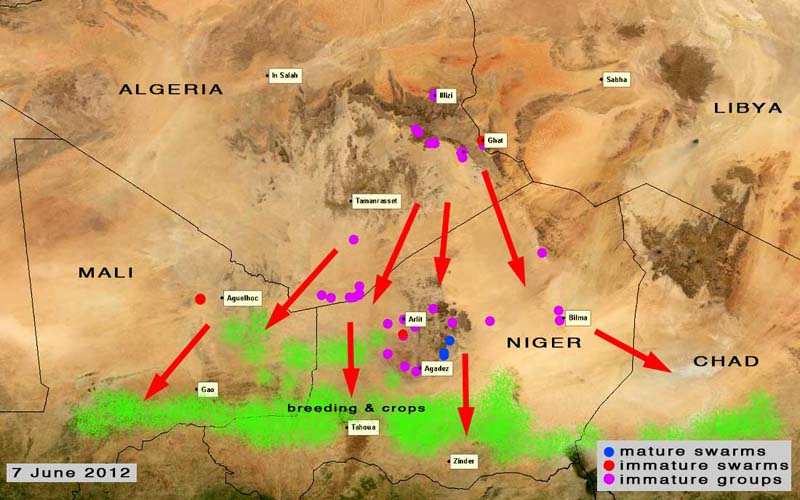
Desert Locusts arrive in Niger and Mali and move to breeding areas.
1 June. ALERT! Locusts start to arrive in northern Sahel
On the evening of 30 May, a group of Desert Locust adults appeared in cultivations near Arlit in northern Niger. It is expected that this group arrived from current infestations further north in southeast Algeria as groups of immature adults were reported moving south between Bordj El Haoues (west of Djanet) and Tamanrasset on 23-26 May.
Although control operations continue against mainly groups of immature adults in southeast Algeria and immature swarms in southwest Libya, efforts are limited by insecurity.
Therefore, more groups of immature adults and probably some small swarms are expected to arrive in the coming weeks in northern Niger (Tamesna Plains and Air Mountains), perhaps in northeastern Mali (Tamesna Plains, Adrar des Iforas), to a lesser extent in northeast Niger (Djado Plateau, Dirko to Seguedine), and maybe northwest Chad. Heavy rains fell in late May over the Djado Plateau and light rain fell in mid-May in parts of Tamesna. Locusts will either concentrate in the few areas that are green from recent rains and in crops, or continue south to cropping areas in central and southern Niger.
National survey and control teams are being mobilized in Niger. Insecurity in northern Niger and Mali will hamper operations.
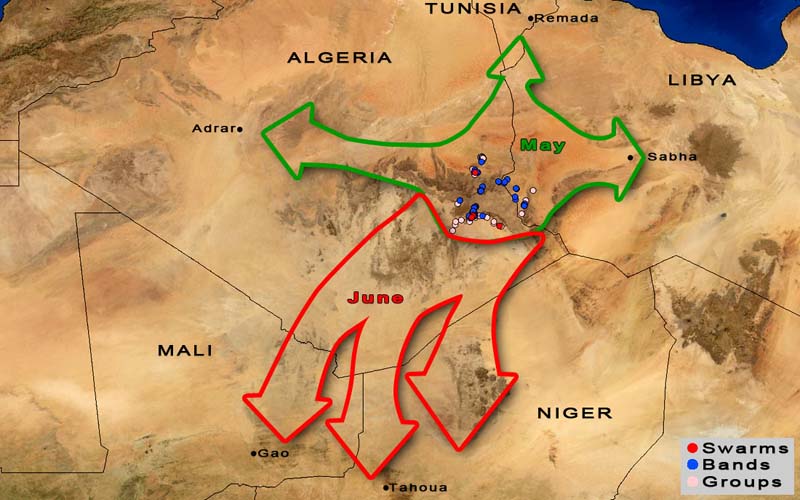
Anticipated Desert Locust movements in May and June.
28 May. Adult groups move south towards Tamanrasset, Algeria
Small but dense immature Desert Locust swarms continue to form in southwest Libya while only groups of immature adults have been reported recently in adjacent areas of southeast Algeria. Some of the adult groups have moved nearly 250 km towards the southwest from the southern side of the Tassili Mountains. A few hopper bands and some groups of hoppers continue to develop in the northern part of the outbreak area near Illizi, Algeria and on the southern edge of the Al Hamada Al Hamra plateau in Libya.
Ground control operations are in progress in both countries, albeit at a slightly reduced level, treating 6,635 ha in Algeria (18-27 May) and 2,405 ha in Libya (18-23 May).
Mali and Niger should remain on high alert as there is a strong possibility of some swarms moving south into the Sahel of both countries, especially if pre-seasonal rains fall before the summer. Light rain may have already fallen in some of these areas in mid-May. The situation is potentially very dangerous because swarms could eventually invade the Sahel of West Africa at the beginning of the rainy season when farmers are planting. Therefore, all efforts are required to monitor the situation now and undertake the necessary control operations to reduce current population levels.
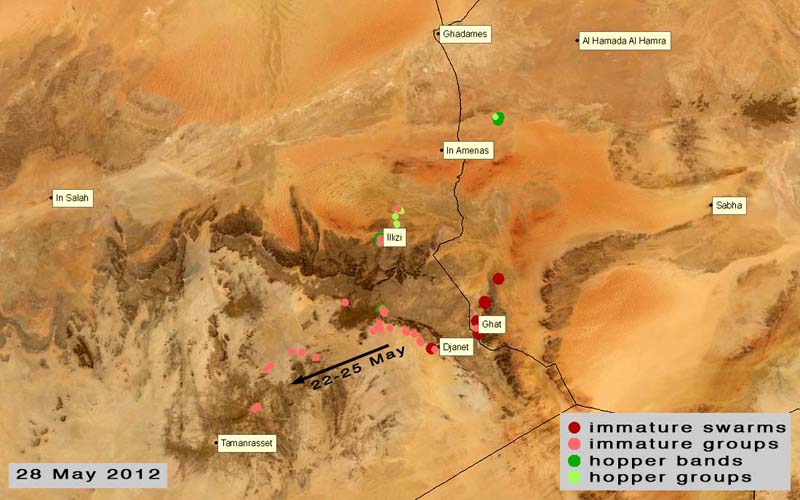
Some adult groups moved south in SE Algeria.
18 May. A few very small swarms form in southeast Algeria
During the second week of May, a few very small immature swarms started to form on the southern and northern sides of the Tassili-Ajjer Mountains in southeast Algeria. The swarms, varying in size from 60 to 200 ha, were seen at four places in the Bordj El Haoues area west of Djanet and at one location near Illizi. Some of the swarms were seen flying in a general northeast to southwest direction. Hopper groups and bands as well as groups of immature adults are also present in both areas and in a few wadis in the Tassili. In adjacent areas of southwest Libya, hopper bands and groups of immature adults are present north of Ghat. No further egg laying or hatching was reported in either country.
Ground control operations continue in both countries. National teams treated 12,161 ha in Algeria (10-17 May) and 3,210 ha in Libya (6-16 May). In Algeria, seven survey teams and 17 control teams are operating in the infested areas.
Although conditions are drying out in many places, there is probably still a sufficient amount of green vegetation in low-lying areas to allow locust adults to remain in the general area for at least the next few weeks.
Nevertheless, Mali and Niger should be on high alert as there is a strong possibility of some swarms moving south into the northern Sahel of both countries, especially if pre-seasonal rains fall before the summer. Light rain may have already fallen in some of these areas at mid-month.
The situation is potentially very dangerous because swarms could eventually invade the northern Sahel of West Africa at the beginning of the rainy season when farmers are planting. Therefore, all efforts are required to monitor the situation now and undertake the necessary control operations to reduce current population levels.
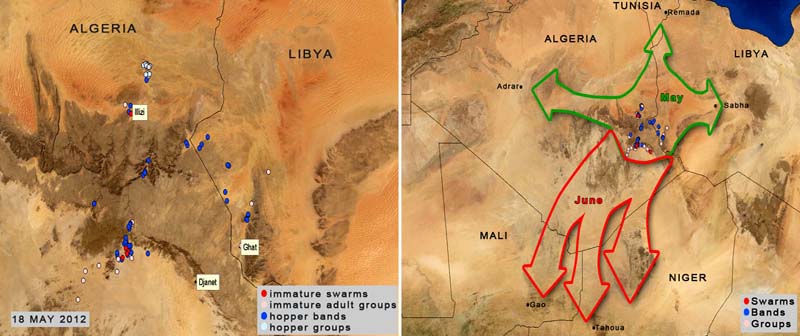
Swarms are forming in southeast Algeria and expected to move in May and June.
11 May. New adults forming groups in Algeria and Libya; swarm formation expected soon
Mainly late instar Desert Locust hopper bands are currently present along both sides of the border in southwest Libya and southeast Algeria where an outbreak developed earlier this year. At the end of last week, hoppers started to fledge into winged immature adults. The fledglings and immature adults are forming groups at densities up to 800 locusts/m2, mainly in southeast Algeria and to a lesser extent in southwest Libya. Immature swarms are expected to start forming in the coming days and an increasing number of swarms are likely to be reported as the month progresses. The swarms are likely to remain in the area as long as ecological conditions remain favorable.
Egg-laying, hatching and the formation of early instar hopper groups are still in progress in the northern part of the outbreak area near Illizi, Algeria and on the southern edge of the Al Hamada Al Hamra plateau in northwest Libya. As mentioned earlier, late instar hopper bands are present in Libya northwest of Ghat and in southeast Algeria to the north and south of the Tassili-Ajjer Mountains west of Djanet and north of Illizi.
Ground control operations are in progress in both countries. National teams treated nearly 15,600 ha in Algeria (26 April - 9 May) and 3,000 ha in Libya (26 April - 3 May). Insecurity and remoteness continue to limit survey and control operations.
The situation is potentially very dangerous because swarms could eventually invade the northern Sahel of West Africa at the beginning of the rainy season when farmers are planting. Therefore, all efforts are required to monitor the situation now and undertake the necessary control operations to reduce current population levels.
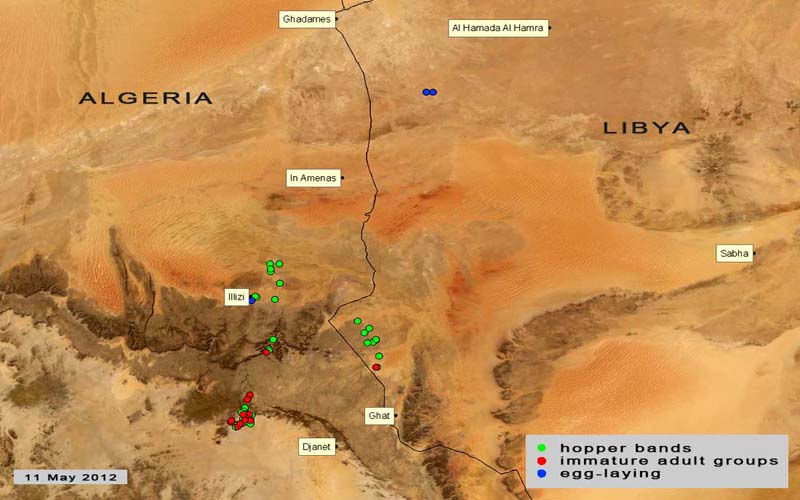
Fledglings are forming groups of immature adults in Libya and Algeria.
3 May. Hopper bands continue to form in Algeria and Libya; swarm formation imminent
The Desert Locust situation continues to remain extremely serious along both sides of the border in southwest Libya and southeast Algeria. Small but dense hopper bands are forming in Libya northwest of Ghat and in Algeria on both sides of the Tassili-Ajjer Mountains near Djanet and Illizi. Recently, hatching was seen north of Illizi and groups of adults were copulating north of the outbreak area in northwest Libya near Ghadames and the Al Hamada Al Hamra plateau. This confirms the earlier suspicion that infestations are more widespread than indicated by the ground survey results. National teams treated 3,360 ha in Algeria and 3,535 ha in Libya on 1-25 April.
Hatching is expected to continue to about mid-May north of Tassili in Algeria and will occur near Ghadames and the Al Hamada Al Hamra in northwest Libya. More hopper bands will form in both countries during May. Fledging should commence in early May and last for about one month during which an increasing number of immature groups and swarms are expected to form. By the end of May, adults could be ready to lay another generation of eggs that could hatch as early as the second week of June if conditions remain favourable. Adult groups and swarms are likely to remain in the current outbreak area during May but could start to move southwards in June.
The situation is potentially very dangerous because swarms could eventually invade the northern Sahel of West Africa at the beginning of the rainy season when farmers are planting. Therefore, all efforts are required to monitor the situation now and undertake the necessary control operations to reduce population levels.
Elsewhere, the situation remains calm. Scattered adults may move from central to northern Oman and breed on a small scale in areas of recent rainfall. Good rains fell in northern Mauritania and Western Sahara where small scale breeding could occur in May.
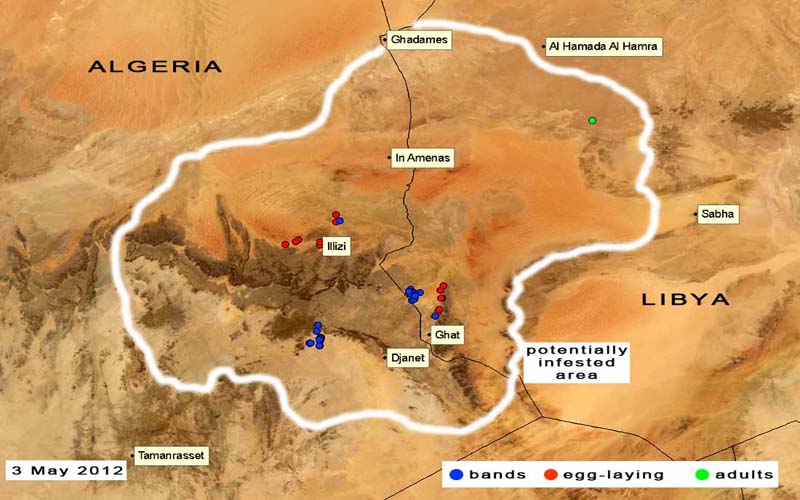
Hopper bands are forming in Libya and Algeria.
26 April. Hopper bands continue to form in Libya and Algeria
During the past two weeks, hatching and hopper bands continued to form in southwest Libya and adjacent areas of southeast Algeria. More hatching and band formation is expected during May near Illizi, Algeria. At present, most of the hoppers in Libya have reached the fifth and last stage while in Algeria they have reached the fourth instar stage. This means that fledging will commence next week and new immature swarms are likely to start forming by mid-May in both countries. As long as ecological conditions stay favourable, adults and swarms are likely to remain in the currently infested areas and perhaps move slightly north towards In Amenas, Algeria and Ghadames, Libya or east towards Sabha during periods of warm southerly winds.
The new generation of adults will mature during May and could start to lay eggs for a third generation of breeding by early June in those areas where soil is moist. In this case, hatching and hopper band formation will take place in June and a third generation of swarms could form during July. This would represent an extremely serious threat to the northern Sahel in Mali and Niger that would coincide with the summer rainy season and planting period.
The area that is potentially infested is much larger than indicated by current survey results because many areas cannot be accessed due to insecurity and remoteness. Analysis of high resolution satellite imagery suggests that current infestations in Algeria represent only about 15 percent of total infestations present between Djanet and Illizi. No locusts were seen during recent surveys in the Al Hamada Al Hamra in northwest Libya except at one location in the extreme south where mature adults were present. This may suggest that the extent of outbreak area in southwest Libya remains south of the Al Hamada Al Hamra.
So far this month, ground teams treated 3,360 ha in Algeria and 3,535 ha in Libya. FAO is providing technical assistance to Libya.
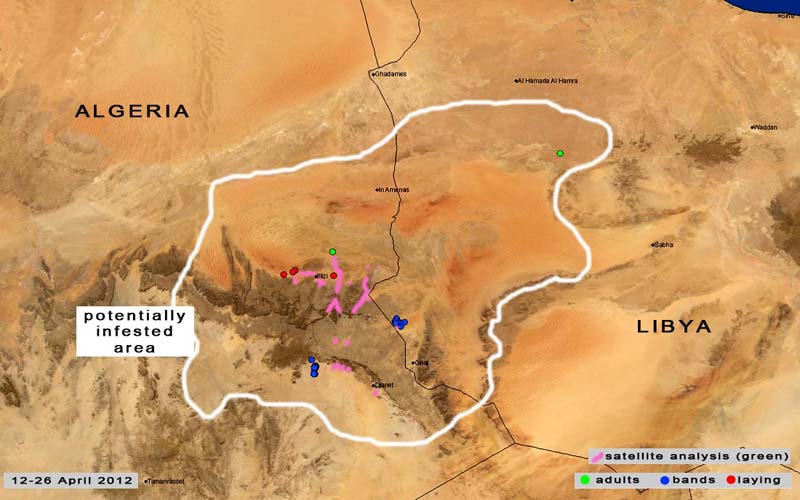
Hopper bands are forming in Libya and Algeria.
11 April. Hatching and band formation start in Libya and Algeria
A second generation of hatching commenced in late March and early April in southwest Libya and southeast Algeria where a Desert Locust outbreak is in progress. This is expected to cause locust numbers to increase significantly on both sides of the common border and lead to a potentially dangerous situation in which swarms form and invade the northern Sahel of West Africa at the beginning of summer.
Currently, the hatchlings are forming many dense hopper groups and bands in both countries at densities of more than 5,000 hoppers/sq. metre. Some of the hoppers have reached the second instar stage in Libya while hoppers in Algeria are first instar. The infestations are present in areas where adults laid eggs in late February and throughout March, mainly northwest of Ghat (Libya), extending west to Wadi Tarat and Illizi in Algeria and on the southern side of the Tassili-Ajjer Mountains west of Djanet. New infestations have been found in previously unreported areas north of Ghat on the eastern side of Jebel Idinin. Groups of adults are still present and laying eggs in some areas.
Ground teams are monitoring the situation in both countries but there are large areas that are inaccessible due to remoteness and insecurity that may be infested. So far this month, control teams have treated 1,325 ha in Libya and 910 ha in Algeria. Additional teams are being deployed this week in both countries and FAO is providing assistance to Libya.
The hoppers are expected to start fledging from the second week of May onwards. Thereafter, small groups and swarms of immature adults are expected to form along both sides of the border. Therefore, all efforts are required to survey as many areas as possible and undertake the necessary control operations during April in order to reduce the threat of any eventual migration to the northern Sahel in Mali and Niger at the beginning of the summer.
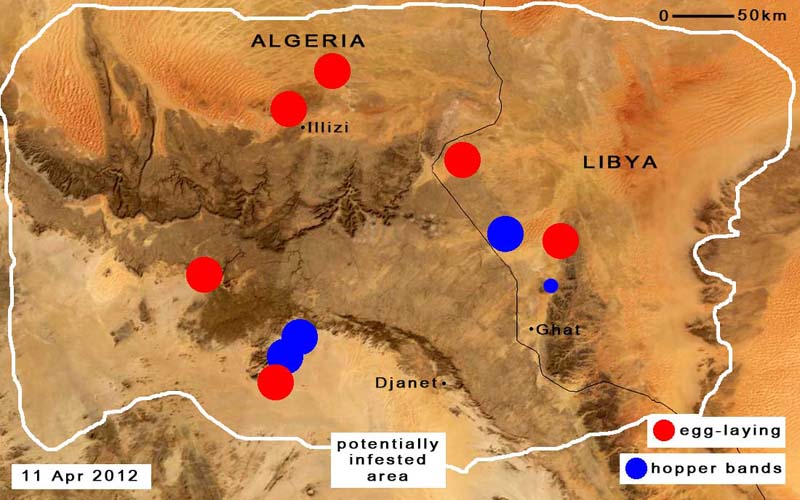
Hatching will cause locust numbers to increase during April.
4 April. Hatching expected shortly in Libya and Algeria
Ground survey and control operations are in progress in southwest Libya and southeast Algeria where groups of gregarizing Desert Locust adults have been laying eggs throughout March. Although hatching has not been reported yet, it is expected to occur in the coming days as temperatures warm up.
Once hatching commences, locust numbers will almost certainly increase dramatically in both countries, and numerous hopper groups and small bands are expected to form. By late May, hoppers will fledge and the immature adults are likely to form swarms.
Although national teams treated more than 3,600 ha in Libya and nearly 1,500 ha in Algeria during March, there are many areas where egg-laying may have occurred but cannot be accessed due to remoteness or insecurity.
Therefore, all efforts are required to survey as many areas as possible and undertake the necessary control operations before the end of May in order to reduce the threat of any eventual migration to the northern Sahel in Mali and Niger at the beginning of the summer.
Elsewhere, the Desert Locust situation is calm. Small-scale breeding may occur in southeastern Iran and western Pakistan if rains fall during April.
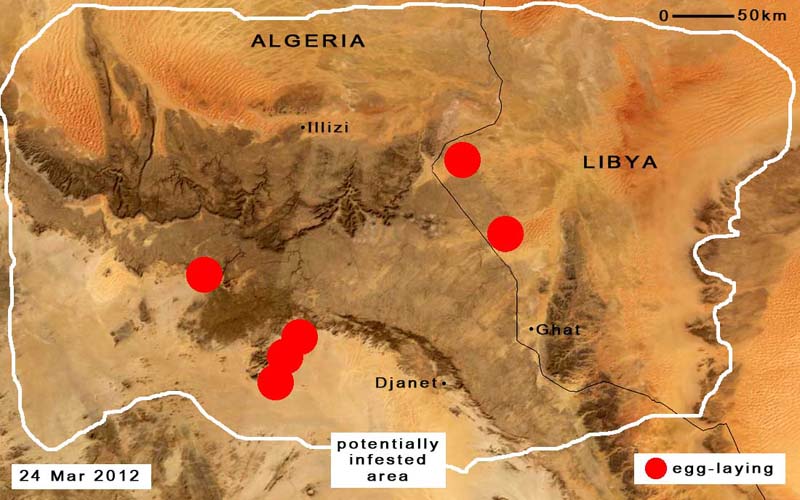
Current infestations may be present within a much larger area than reported in Libya and Algeria.
25 March. Hatching will cause locusts to increase in Libya and Algeria
The current Desert Locust situation remains potentially threatening along both sides of the Libya-Algeria border. Although national teams are surveying and treating adult infestations in southwest Libya near Ghat and in southeast Algeria near Djanet, the situation is less well known in other areas due to insecurity and remoteness.
In Libya, medium to high density groups of mature gregarious adults have been copulating and laying eggs at nearly two dozen locations near the Algerian border north of Ghat throughout this month. Infested areas vary from less than 10 ha to almost 200 ha. So far this month, ground teams have treated nearly 3,000 ha.
In adjacent areas of southeast Algeria, groups of mature transiens adults are copulating and laying eggs at less than a dozen places about 200 km southwest of the Libyan infestations on the southern side of the Tassili N'Ajjer Mountains west of Djanet. Adult densities and the size of the infested areas are similar to those in Libya. Ground teams treated nearly 1,700 ha since 6 March.
As hatching commences in the coming weeks, locust numbers are expected to increase significantly in both countries. Small but numerous hopper bands are likely to form during April with new adults appearing in May.
All efforts are required to survey as many areas as possible and undertake the necessary control operations in order to reduce the threat of any potential migration to Mali and Niger at the beginning of the summer.

Current infestations may be present within a much larger area than reported in Libya and Algeria.
7 March. Egg-laying in SE Algeria
New reports indicate that groups of transiens and gregarious mature adults are laying eggs in southeast Algeria to the west of Djanet near Bordj El Haoues. Up to 6 adults were seen per sq. metre. Ecological conditions are extremely favourable for breeding. Ground teams treated 175 ha from 29 February to 5 March. The situation is calm in other parts of the country.
Similar to southwest Libya, hatching will occur by the end of March and continue into early April, followed by the formation of hopper bands.
The current situation is potentially threatening. As hatching occurs, there is a high risk that locust numbers will increase dramatically near Ghat and probably in adjacent areas of SE Algeria and W Libya where rains fell in mid-February and the locust situation is not well known. Current insecurity along both sides of the border is hampering field operations.
Consequently, all efforts are required to conduct surveys in areas of recent rain and run-off, and to undertake control operations as necessary.
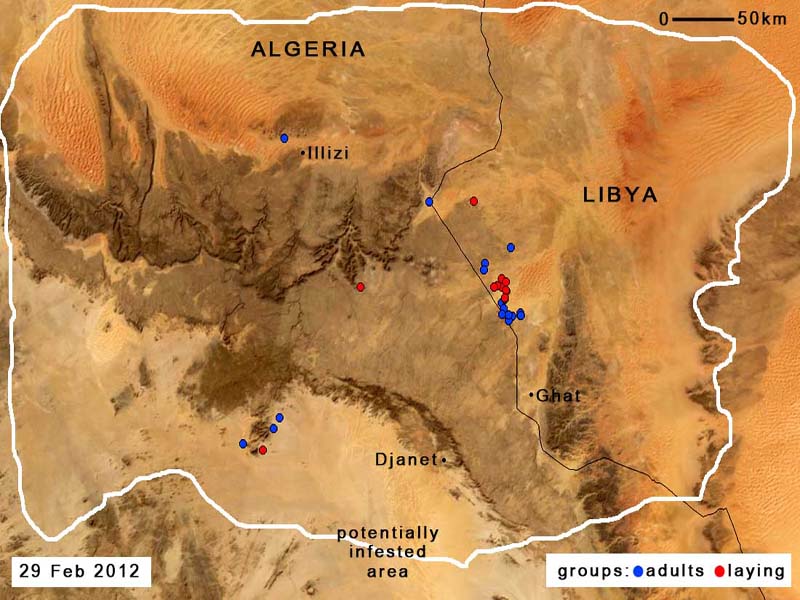
Current infestations may be present within a much larger area than reported in Libya and Algeria.
1 March. Locusts may dramatically increase in SW Libya outbreak
During the last week of February, an increasing number of adults were seen copulating and ready to lay eggs in areas of recent rainfall within the current outbreak area in southwest Libya. Most of the adults were gregarious and had formed medium to high density groups. Although ground teams treated 835 ha from 20 to 29 February, it is likely that a second generation of breeding will occur with hatching during the second half of March and early April, followed by the formation of hopper bands.
The current situation is potentially threatening. As hatching occurs, there is a high risk that locust numbers will increase dramatically near Ghat and probably in adjacent areas of SE Algeria and W Libya where rains fell last month and the locust situation is not well known. Current insecurity along both sides of the border is hampering field operations.
Consequently, all efforts are required to conduct surveys in areas of recent rain and run-off, and to undertake control operations as necessary.

Current infestations may be present within a much larger area than reported in Libya and Algeria.
20 February. Good rains in Libyan outbreak area
The small outbreak in SW Libya continues to develop near Ghat and the Algerian border. National teams are undertaking survey and control operations in Libya and Algeria. So far, ground teams have treated 1,530 ha in Libya and 190 ha in Algeria during February. While most of the infestations remain in a relatively small area northwest of Ghat, new infestations have been found east of Tarat on the Algerian/Libyan border, about 40 km north of earlier infestations. Mature transiens adults (700 adults/ha) were seen copulating and immature gregarious adults (2,000 adults/ha) were reported in the past few days. Medium to dense infestations of third to fifth instar hoppers were also present.
Good rains fell on 18-19 February over the infested areas, stretching from Tamanrasset, Algeria to Mizda, Libya. These rains will allow ecological conditions to remain favorable for breeding, which will cause locust numbers to increase further in the coming months. Hatching is expected to commence shortly that could lead to the formation of small hopper groups and bands. If more rains fall during the spring as temperatures increase, the situation could deteriorate further.
Consequently, there is a high risk that locust infestations may be currently present within a much larger area than reported. All efforts are required to conduct surveys in areas of recent rain and run-off, and to undertake control operations as necessary.
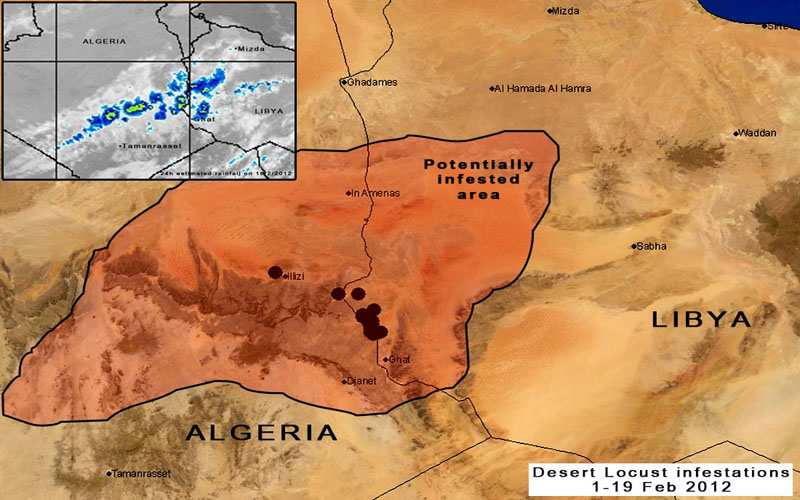
Current infestations may be present within a much larger area than reported in Libya and Algeria.
9 February. Locust outbreak in SW Libya
A small outbreak of Desert Locust has developed in southwest Libya near Ghat and the Algerian border. In early January, hoppers started to concentrate and form small patches in a few wadis, increasing in density to up to 400 hoppers per bush. By the end of the month, locust numbers had increased as well as the number of places infested with locusts. Most of the hoppers had fledged and the newly immature adults were forming groups. There were reports of a small medium density maturing swarm flying near the Algerian border on 4 and 6 February. Some of the adults had already matured and were seen copulating on the 6th at densities up to 500 adults/100m2.
At least two survey and control teams are in the area to monitor the situation and treat infestations with vehicle-mounted sprayers. Nearly 3,000 ha are estimated to be infested and, so far, teams have treated 1,030 ha during the first week of February.
Locust numbers are expected to increase further as hatching commences by the end of the month and hoppers form small groups and bands. There is a risk that adult groups and small swarms could move towards the north during periods of warm southerly winds and reach Ghadames and Al Hamada Al Hamra. The current infestations may extend across the border into eastern Algeria.
UPDATE. In southeast Algeria, an increasing number of solitary immature adults were seen near Illizi from 7 February onwards. Adults were also seen on the Libyan border. Trajectory models suggest that the adults are coming from the current infestations near Ghat, Libya. Algerian ground teams treated 190 ha so far. Additional teams will be deployed to the area.
All efforts are required to monitor the situation closely and undertake the necessary control operations to prevent the situation from deteriorating further and spreading.
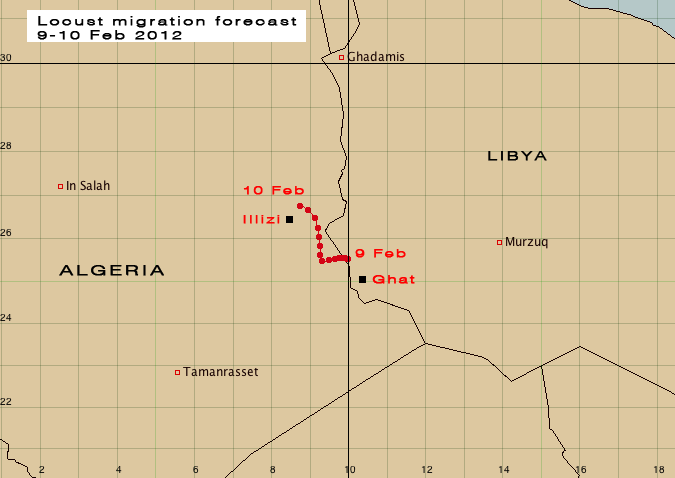
Adults are likely to move NW from Ghat, Libya to Illizi, Algeria on 9-10 February.
8 February. Locust outbreak in SW Libya
A small outbreak of Desert Locust has developed in southwest Libya near Ghat and the Algerian border. In early January, hoppers started to concentrate and form small patches in a few wadis, increasing in density to up to 400 hoppers per bush. By the end of the month, locust numbers had increased as well as the number of places infested with locusts. Most of the hoppers had fledged and the newly immature adults were forming groups. There were reports of a small medium density maturing swarm flying near the Algerian border on 4 and 6 February. Some of the adults had already matured and were seen copulating on the 6th at densities up to 500 adults/100m2.
At least two survey and control teams are in the area to monitor the situation and treat infestations with vehicle-mounted sprayers. Nearly 3,000 ha are estimated to be infested and, so far, teams have treated 1,030 ha during the first week of February.
Locust numbers are expected to increase further as hatching commences by the end of the month and hoppers form small groups and bands. There is a risk that adult groups and small swarms could move towards the north during periods of warm southerly winds and reach Ghadames and Al Hamada Al Hamra. The current infestations may extend across the border into eastern Algeria.
All efforts are required to monitor the situation closely and undertake the necessary control operations to prevent the situation from deteriorating further and spreading.
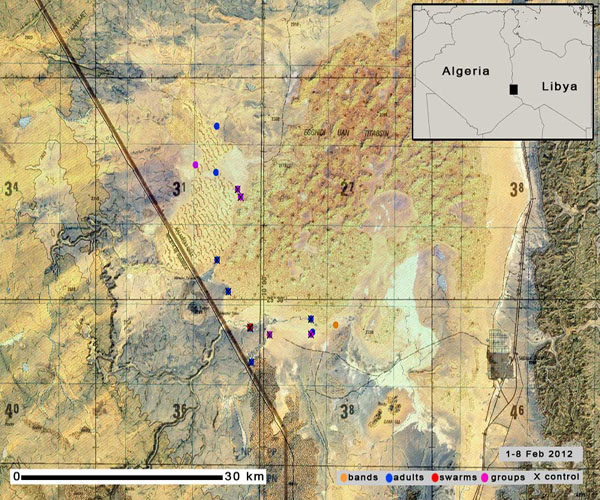
A few small hopper bands and swarms form in SW Libya near Algeria.
2 February. Situation remains calm but close monitoring is required in Libya, Algeria and Niger
During January, small-scale breeding occurred in southwest Libya and in adjacent areas of southeast Algeria. In Libya, hoppers were becoming gregarious and forming several small patches in three places northwest of Ghat. In Algeria, hopper and adult densities were increasing west of Djanet. Ground teams treated 85 ha in Algeria while in Libya all attempts were being made to organize survey and control operations. In Niger, small-scale breeding occurred in the eastern Air Mountains and on the western side of the Ténéré Desert where low numbers of hoppers and adults are currently present. Close monitoring is required in all three countries, especially if more rains fall that would allow further breeding, concentration and grouping.
In the winter breeding area along both sides of the Red Sea and Gulf of Aden, locust numbers continue to remain unusually low due to poor rains and dry vegetation. Only a few adults have been reported in the Tokar Delta and southern plains in Sudan, and near Qunfidah in Saudi Arabia. Further breeding is unlikely unless more rain falls.
In the spring breeding areas of SW Asia, only a few adults were seen on the coast in western Pakistan near Uthal. Vegetation is starting to become green in a few places on the coast in southeast Iran. More rain is required before breeding conditions become favourable.
No significant developments are likely during February.
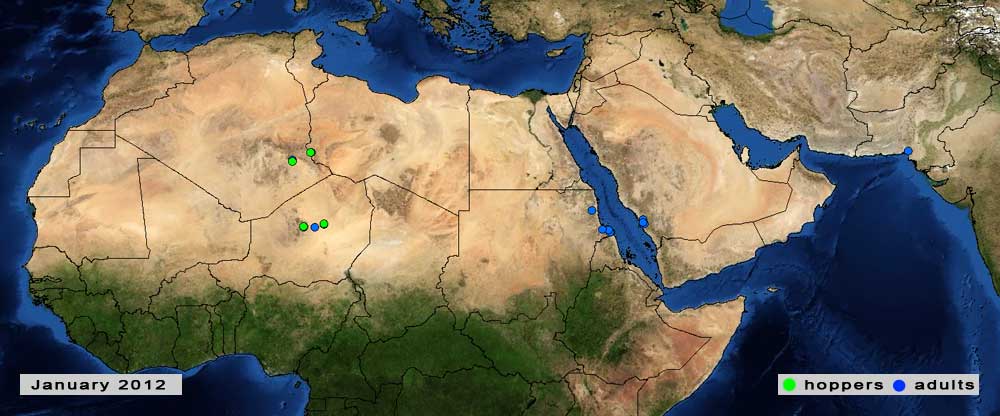
Low numbers of locusts are present in a few countries.
3 January. Poor rains limit Desert Locust breeding on the Red Sea coast
The Desert Locust situation continues to remain calm. Very little rain fell during December in the winter breeding areas along both sides of the Red Sea. Consequently, only low numbers of locust adults were present on the coast south of Tokar Delta in Sudan, near Shelshela in Eritrea, near Qunfidah in Saudi Arabia, and near Suq Abs in Yemen. Small-scale breeding will occur in January if more rains fall in coastal areas and locust numbers will increase slightly but remain below threatening levels. Small-scale breeding may also occur in areas that received rainfall during October and November along the eastern coast of Oman between Salalah and Sur. Breeding is unlikely to occur along either side of the Gulf of Aden unless more rains fall on the coast of southern Yemen or in northwest Somalia.
In the Western Region, ecological conditions remained dry excepted for a few isolated patches of green vegetation in northwest Mauritania, northern Mali and southeast of the Hoggar Mountains in southern Algeria. Although locust numbers declined in northwest Mauritania last month, a few isolated adults are likely to persist there during January. In Niger, good rains fell in the Air Mountains where small-scale breeding was in progress and is likely to continue during January but locust numbers are expected to remain below threatening levels.
In South-West Asia, a few isolated adults were seen recently on the coast of western Pakistan near Pasni. Small-scale breeding is likely to commence if additional rains fall in coastal areas between the Strait of Hormuz in Iran to Karachi, Pakistan.
No significant developments are expected during January in the recession area.
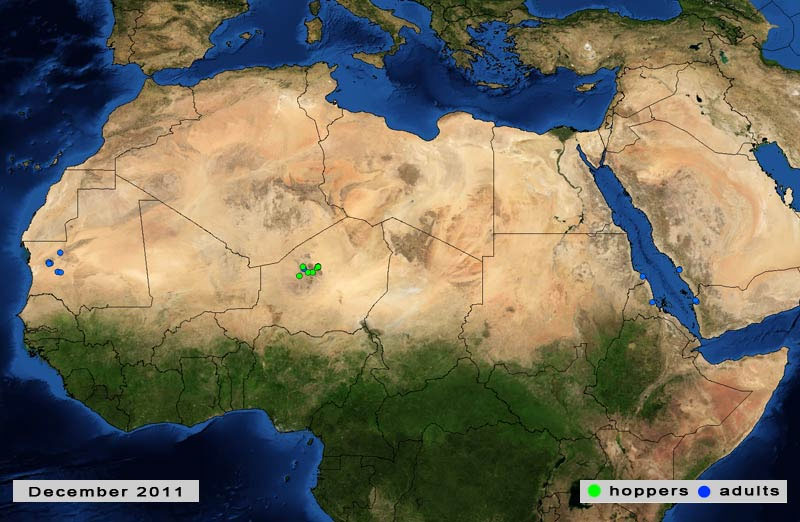
Low numbers of locusts are present in a few countries.




